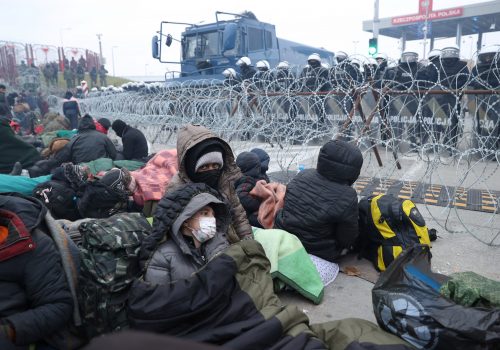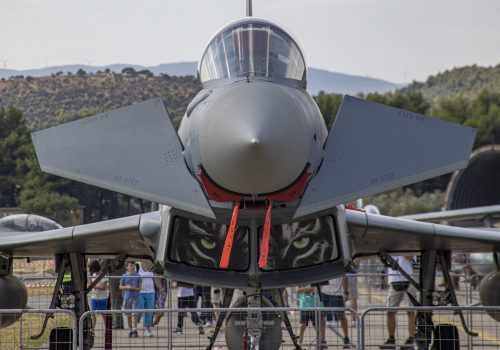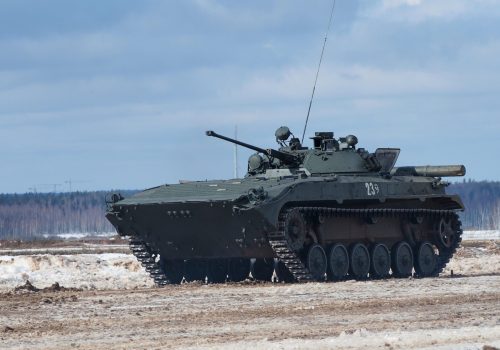As veterans of the intelligence and special-operations communities, we’ve both dedicated our lives to protecting the United States and its interests abroad. Following the September 11 attacks, much of this time was spent on fighting terrorism and countering adversaries in the Middle East and South Asia. Through it all, we’ve learned a fundamental truth: The world waits for no one.
Now, the United States acknowledges that it’s locked in a long-term strategic competition with China and Russia, both of which embrace a particular type of conflict: hybrid warfare. It is fought most frequently in the shadows and what experts call the “gray zone”—falling below the threshold of conventional armed conflict—and utilizes far more than just conventional forces.
Russian President Vladimir Putin, for example, has made hybrid warfare a matter of national policy over the past two decades. His toolkit is formidable, ranging from offensive cyber operations to non-attributable physical attacks. Some of the most notorious examples include the 2015 hack of Ukraine’s power grid (reportedly by a Russian hacking group), the Kremlin’s interference in the 2016 US presidential election (which fueled a lasting erosion of confidence in the voting process and other US democratic institutions), and the 2018 nerve-agent attack on former Russian operative Sergei Skripal in the United Kingdom.
Each of these incidents stands out for their brazen nature, defying the accepted norms of statecraft for a reputable member of the international community—and especially for a permanent, nuclear-armed member of the United Nations Security Council with “great power” ambitions. And as tensions over Ukraine continue rising, the Kremlin is expected to employ its time-tested playbook again.
So far, the United States and its international partners have proven unwilling to respond forcefully enough. Thanks in part to that inaction, Russia continued its malign practices: In 2017, Russian malware infected computer systems worldwide, including the US health care sector, while the Kremlin continued meddling in global elections and assassinating its foes.
Is Washington playing checkers while its adversaries are playing chess? Does it have the tools and, perhaps more importantly, the will and fortitude to effectively operate in this arena?
A recipe for action
In order to discourage such gray-zone operations, and to maintain its long-term competitive advantage across all domains, the United States must effectively respond to hybrid-warfare campaigns. But being reactive is not enough, since that forces the United States to play according to its adversaries’ rules rather than setting its own. At best, being reactive is chaotic and imprecise; at worst, it is ineffective or even delayed to the point of irrelevance.
An effective response is one that is inherently proactive, based on elements that are in place well ahead of time. While responses to hybrid warfare should differ from one another depending on the situation, the aggressor, and the severity of the activities, these common elements must all be present:
- Timely attribution: The United States must be able to more rapidly identify perpetrators with an acceptable level of confidence. It must also improve releasability to partners, including the ability to declassify information in relevant and actionable timeframes. Currently, the inability to nail down timely releasable attribution on some of the most egregious examples, including anomalous health incidents or bounties on troops serving in Afghanistan, continues to hinder the US ability to counter and prevent repeat events.
- Pain points: The United States needs to accurately assess the most vulnerable points of bad actors to counter and shape their behavior. For example, simply sanctioning the Russian economy would be ineffective because it does not move the needle for Putin and his coterie of enablers; rather, it worsens an already unfavorable view of the West among the Russian people. Instead, the United States must apply real pressure against the sources of Russian money and other support, particularly in the West. Effective responses to gray-zone activities are also not necessarily limited to the gray zone—meaning the United States could be within its rights to respond with a kinetic strike following a cyberattack on critical financial infrastructure or interference with global communications. It must similarly be mindful of pain points for allies and potential partners, such as reliance on energy or foreign investment from adversarial nations, or it will fail to gain support when needed.
- Tempo and sequencing: Effective responses need to occur quickly, or they won’t even be viewed as responses. Additionally, they need to be timed and sequenced to stun, overwhelm, or disrupt the activities in question, creating what’s known in special operations and intelligence circles as “violence of action”—whether kinetic or non-kinetic. Effective responses should make adversaries feel as if they have overplayed their hand, and that things will rapidly deteriorate if they fail to de-escalate. To be dissuaded from such actions in the future, bad actors need to viscerally remember the stinging pain of regret.
- Strategic coordination: Uncoordinated responses are ineffective ones. Any response must be weighed in the big picture of what the current or future US National Security Strategy is trying to accomplish inside the gray zone and in hybrid warfare writ large. Responses should be shaped and executed appropriately. An uncoordinated but successful operation may meet all its objectives, but still create more harm than good if it is not in line with national strategy. For example, the US Intelligence Community reportedly assessed with low to moderate confidence that Russia had offered bounties to the Taliban on US and NATO troops serving in Afghanistan. But that was later publicly called into question by senior US officials, and the uncoordinated public discussion complicated any resulting retaliatory actions—potentially impacting US international standing.
- Effects-based messaging: An effective response must have a deliberate effects-based message at its core, coordinated to shape adversary behavior within the competition continuum. This applies even if that message will be unspoken. Without a deliberate planned message to shape behavior, US responses may not only lack their intended effect, but the takeaway could actually have the opposite effect. When it comes to potential new sanctions against Russian oligarchs, for instance, it is important—even while threatening such measures—to clearly and publicly communicate the role those oligarchs play in enabling Russian aggression.
To stay one step ahead of their adversaries and counter them in the gray zone, the United States and its allies must provide effective responses—not just reactions. Bad actors are both openly embracing and actively engaging in hybrid warfare, and time is of the essence for Washington to seize the advantage and get them to play its own game.
Marc Polymeropoulos and Arun Iyer are nonresident senior fellows in the Atlantic Council’s Scowcroft Center for Strategy and Security and its Forward Defense practice. Both are veterans of the intelligence and special operations communities, with nearly fifty years of service combined.
Further reading
Mon, Nov 15, 2021
Belarus dictator turns hybrid war into humanitarian crisis
BelarusAlert By
By weaponizing migrants in his hybrid war against the European Union, Belarus dictator Alyaksandr Lukashenka has created an escalating humanitarian crisis on his country's border with Poland.
Tue, Feb 1, 2022
The EU’s Strategic Compass is a defining moment for European defense
New Atlanticist By Marie Jourdain
The EU's first white paper on defense will be a barometer for both member states’ and the bloc’s ambitions to make the EU a leading provider of security.
Tue, Feb 8, 2022
Russian Hybrid Threats Report: New evidence of accelerated military build-up near Ukraine
New Atlanticist By
The Council’s open-source researchers reveal the latest Russian troop, aircraft, and weapons movements around Ukraine, along with new Kremlin disinformation efforts.
Image: A binary code is displayed on a laptop screen in this illustration photo taken in Krakow, Poland, on August 17, 2021. Photo by Jakub Porzycki/NurPhoto/REUTERS



